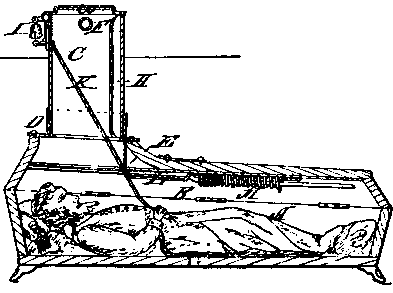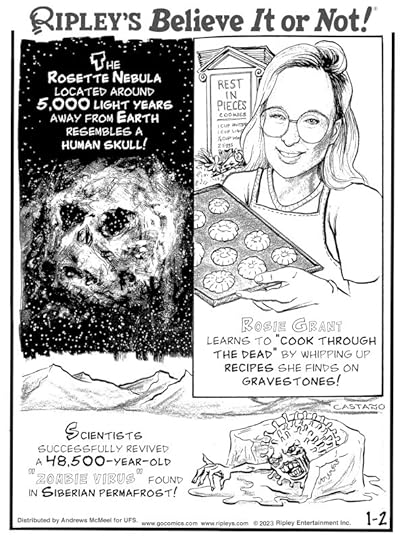Ripley Entertainment Inc.'s Blog, page 47
January 6, 2023
Lost for Decades, Wallet and Ring Returned to Original Owners
Featured in Ripley's Believe It or Not!

Two stories of lost items reappearing decades later hit the headlines as 2022 wrapped up, seemingly reminding all of us as the new year approached that there is reason to hope after all!
A Wallet Full of MemoriesA contractor in Fayetteville, West Virginia, found and returned a wallet that a student lost during a high school dance in 1968. It belonged to Sharon Sue Tyler who was just 16 years old when the item disappeared, according to WVVA.
The Fayetteville Grade School, which hosted dances for older students, closed in 2019, and Bradley Scott of New River Contracting was renovating the building in December 2022 to make space for new apartments when the wallet dropped out of the ductwork. The item was tucked inside with other objects in a space that was bolted shut. It’s unclear how the wallet ended up there.
Scott explained, “There was some old admission tickets to a boxing match and some other things that all fell out of there when we broke that loose and opened it up for the first time in 100 years.”
The Search BeginsRather than just toss the wallet into the trash with construction debris, Scott decided to post about it on Facebook in the hopes of tracking down the original owner. He thought the woman may still live in the area and may be interested in reclaiming the photos and social security card inside.
The wallet’s owner, who is now known as Sharon Day, found out about the wallet from her sister and was excited to see its contents again: “I like my pictures of the people that I went to school with and friends. It’s something that I never thought I would see or know what was going on about it.”
With Day’s permission, Scott wrote a follow-up post that contained the photos in the wallet, and several Facebook users “recognized loved ones, relatives, and classmates.” Day’s daughter, Suzanna, explained in the comments that her mother did not remember losing the wallet or know who it ended up in the duct work. Another Facebook user suggested Day lost it through a high school prank.
Blast from the PastMost of the images Day collected were black and white and a snapshot of the 1960s generation. The year the wallet was lost, 1968, was a turbulent one for America — Martin Luther King, Jr., and Robert F. Kennedy were assassinated, and the country was in the midst of the Vietnam War. The year also featured the first interracial kiss on television, courtesy of Star Trek, and Apollo 8 became the first manned spacecraft to orbit the moon.
Day is going to put the photos and other contents of the wallet into a scrapbook.
A Story with a Ring to ItIn related news, an engagement ring that was lost more than two decades ago has also found its way back to its original owner. Shaina Day lost the piece of jewelry at her future-in-laws’ home in Lakeland, Florida, 21 years ago.
Shaina and Nick Day were engaged when the ring accidentally ended up in the toilet at Nick’s parents’ house. Nick told WFLA-TV, “She came to me one day and said, ‘I think I lost my ring.’ She said, ‘It was on the counter now it’s gone and I think I may have flushed it down the toilet on accident.’”
(Happy) Accidents HappenShaina explained what happened on Facebook: “I was cleaning water off the counter with some toilet paper. My ring was sitting on the counter. I must have grabbed my ring by accident and tossed the tp. It was one of the worst things I ever did. I’m still in shock we got it back. We never thought it would get stuck. We thought it was lost in the septic tank.”
Shaina and Nick attempted to find the ring in the septic tank but came up empty. Fast forward 21 years, and the ring resurfaced when a plumber replaced the toilet and found it inside. The couple got it back on Christmas Day 2022.
Now how’s that for some holiday cheer?
By Noelle Talmon, contributor for Ripleys.com
EXPLORE THE ODD IN PERSON! Discover hundreds of strange and unusual artifacts and get hands-on with unbelievable interactives when you visit a Ripley’s Odditorium!Source: Lost for Decades, Wallet and Ring Returned to Original Owners
CARTOON 01-06-2023
January 5, 2023
Meet Grace Good, Circus Artist Extraordinaire!
Featured in Ripley's Believe It or Not!

World-renowned circus artist Grace Good astonishes audiences with aerial feats and fiery stunts, as well as impressive hoop and balancing acts — sometimes combining them all into one jaw-dropping spectacle!
Grace is… GoodGrace began her circus journey teaching herself hoop tricks as a hobby in college, but she soon grew to love the art and began adding extra hoops and fire. Determined to make a career out of hooping, she left school and began performing on the streets of Nashville, Tennessee.

It wasn’t long until Grace was approached by a circus aerialist, who took Grace under her wings. What followed was a whirlwind adventure of learning other circus acts, joining a touring company, going viral on social media, and even performing on national television!
Mind Boggling FeatsAlthough Grace has earned great success, that doesn’t mean she has stopped pushing herself. One of her most recent tricks, and biggest challenges to date, involves her hanging from an aerial silk by one hand while keeping multiple hoops spinning around her body! Believe It or Not!, Grace begins the feat while balanced atop her iconic “big red ball,” which is almost as tall as she is!

From touring internationally with Cirque Dreams, appearing across national television and even performing at various NBA halftime shows, Grace is an unbelievable talent and is able to captivate audiences all over the world.
A Social StarGrace has also found major success on social media as her videos continue to go viral showcasing some of her incredible and eye-catching abilities. With over 3 million followers on TikTok and Instagram, Grace’s addicting content is not to be missed! Catch one of her live performances in Las Vegas or Nashville, or follow the link for upcoming tour dates and see when Grace is coming to a city near you!
Escape the Ordinary With Ripley’s Latest Book!
@gracegoodcirqueTake me higher!I am having an absolutely blast performing at the Ansar Shrine Circus this weekend! I performed so many new tricks and made amazing new circus friends, plus got to perform for thousands of beautiful people! Thank you Springfield IL!♬ Take Me High – Kx5 & deadmau5 & Kaskade
Find this story and more inside Ripley’s all-new book! Escape the Ordinary‘s 256 pages spark curiosity, challenge perception, celebrate differences, and curate a sense of wonder for the weird world around us! Available now on Amazon and at most major retailers.
SAY “NO” TO NORMAL Ripley’s Believe It or Not! Escape the Ordinary transports readers of all ages to a world beyond imagination — where truth is always stranger than fiction! Every turn of the page reveals all-new and all-true stories from around the globe. Filled with stunning photography and engaging content, this book is every curious reader’s ticket to Escape the Ordinary.Is the Phrase ‘Saved by the Bell’ about Being Buried Alive?
Featured in Ripley's Believe It or Not!

You may have heard the popular expression “saved by the bell” in reference to the popular ’90s TV show or because it’s equated to a centuries-old practice in which people were buried with bells in their coffins so they could alert others in case they were inadvertently buried alive. But did this practice actually occur?
Keep reading to learn more, and find the true meaning behind the phrase “saved by the bell.”
Behind the BellThe story goes that during the 17th century people were mistakenly declared dead when they weren’t quite dead either due to a comatose condition or some other malady. In order to give these very-much-alive people a way out, they were buried with a bell tied to a finger or other part of the body. They could then ring the bell to signal someone on the surface, who would stand guard by the grave for 24 hours specifically because they wanted to make sure the corpse was, in fact, a corpse.

via Wikimedia Commons.
In fact, several patents for safety coffins were created in the 19th century just in case an individual was buried alive, according to Smithsonian Magazine. These coffins included a mix of gadgets that allowed them to breathe, alert others, and even escape their graves.
Dr. Johann Gottfried Taberger created a bell system for coffins in 1892. Strings were attached to the body’s head, hands, and feet and were connected to a bell perched above ground, and a cemetery watchman would be alerted if the bell rang, according to History Collection.
Grave ExamplesFamed poet Edgar Allan Poe wrote a short story about the topic. Published in 1844, “Premature Burial” centers on a man with a condition that causes a “death-like trance.” He’s so scared of being buried alive that he builds a tomb that allows him to signal for help in case he’s mistakenly declared dead.

Illustration for Edgar Allan Poe’s story “The Premature Burial” by Harry Clarke (1889-1931), published in 1919. Via Wikimedia Commons.
In addition, there are actual cases in which people were buried alive, which would have necessitated safety coffins. For example, in 1674 a woman named Alice Blunden passed out after drinking copious amounts of poppy tea that may have been infused with codeine and morphine. A doctor declared her dead, but two days later children playing near her grave reported hearing noises.
Authorities dug up the coffin and found Alice’s body covered in bruises determined to be self-inflicted from her struggle six feet under. She was in such bad condition and once again appeared dead, but it was decided to leave her in the coffin unburied with people watching her overnight, just in case. Apparently it had been a rainy night, however, and the watch decided to take refuge indoors and placed the lid back on Alice’s coffin. The next morning, poor Alice was found to have new self-inflicted wounds. This time, sadly, she was truly dead and buried for the final time.
True or False?Patented safety coffins include models that circulate fresh air into the box and battery-powered alarms. However, according to the website I’m a Useless Info Junkie, there’s no proof that people were actually buried in these types of coffins and no evidence that lives were saved because of them.
As for the expression “saved by the bell,” there’s no record of its usage until the 19th century. It was used as boxing slang to indicate the end of a round, not in reference to saving someone who is buried alive. Instead, if a boxer was performing poorly and the bell rang, it “saved” him from being defeated.
By Noelle Talmon, contributor for Ripleys.com
EXPLORE THE ODD IN PERSON! Discover hundreds of strange and unusual artifacts and get hands-on with unbelievable interactives when you visit a Ripley’s Odditorium!Source: Is the Phrase ‘Saved by the Bell’ about Being Buried Alive?
CARTOON 01-05-2023
January 4, 2023
The “Wicked” Bible
Featured in Ripley's Believe It or Not!

People today rely on spell check, Grammarly, and Hemingway to avoid typos in their written work. When the stakes prove especially high, they turn to a professional editor (or several) to help with everything from line editing to overall structure and flow. After all, mistakes in written text can lead to tanking grades, poor reviews for self-published authors, and general egg on the face. As text message fails demonstrate, some people should probably get a second opinion before pressing “send,” too.
While most typological and grammatical errors lead to little more than a chuckle or a minor misunderstanding, one printing mistake in the 17th century proved so unfortunate it cost two men their careers, one man his life, and scandalized religious folks for centuries.
The error even led to a book purge so thorough that only a handful of copies have survived into the present. Here’s everything you need to know about the 1631 King James Bible, deemed “wicked” by King Charles I and the Archbishop of Canterbury.
Into Hot Water the Royal Printers GoThe authorized King James Bible contains 783,137 words. And as for the number of letter characters? The total count comes in at a whopping 3,116,480! That’s a lot to manage in the age of word processors and book writing programs like Scrivener.
But for 17th-century printers, publishing such a work proved incalculably more tedious. After all, they had to hand-set type for every character and space on every page before printing duplicates. The process moved at a snail’s pace, one page at a time. As you can imagine, mistakes happened. Quite a few, actually. But the tolerance level for these inevitable linguistic mishaps varied depending on the text printed.

Credit Wikimedia Commons.
Mistakes could prove especially unfortunate when it came to sacred literature like the Holy Bible. Great Britain’s royal printers, Robert Barker and Martin Lucas, found this out the hard way after securing permission from King Charles I to print a 1631 edition of the King James Bible. The effort produced approximately 1,000 volumes. But after closer inspection of the finished product, Barker and Lucas found themselves in hot water.
A Fatal FlawWhat did the inspection reveal? A tiny but unforgivable omission. In Exodus 20:14, which includes a list of the Ten Commandments, the “not” got left out of “Thou shalt not commit adultery.” The consequences proved swift and severe.
King Charles I expressed extreme outrage, as did the Archbishop of Canterbury, George Abbot. Before they knew what hit them, Barker and Lucas stood summoned before the monarch, receiving a tongue lashing for their lack of care. The royal printers were fined £300 (the equivalent of a month’s salary) and had their printing license revoked. The financial repercussions sent Barker to debtor’s prison repeatedly, and he died on a revolving visit there in 1643.

A section of a page from the Wicked Bible of 1631.
The sovereign also ordered every copy of the “Wicked Bible” hunted down and destroyed. The king’s men carried this out remarkably efficiently, with only 11 or so left in existence today. Interestingly, scholars have since come across a second mistake in Barker and Lucas’ edition. In Deuteronomy 5:24, “God’s greatness” is replaced with “God’s great arse.”
Some scholars argue this second typo is too apparent to have been a careless mistake. In other words, they believe sabotage occurred, likely at the hands of Bonham Norton. Norton may have hoped to secure a royal printing contract, but he had to get Barker and Lucas out of the picture first. If such rumors hold any truth, then Norton outdid himself, inadvertently creating collectibles worth tens of thousands of dollars.
By Engrid Barnett, contributor for Ripleys.com
EXPLORE THE ODD IN PERSON! Discover hundreds of strange and unusual artifacts and get hands-on with unbelievable interactives when you visit a Ripley’s Odditorium!Source: The “Wicked” Bible
CARTOON 01-04-2023
January 3, 2023
The Untold Story of Cat Domestication
Featured in Ripley's Believe It or Not!

People are wild about cats. Worldwide, humans own approximately 370 million of them, only coming in second to man’s best friend, canines. Despite millennia of domesticating kitties, your average house cat still shares 95.6 percent of its genome with tigers. This means they also retain many of their jungle ancestors’ behaviors. From pouncing to prey stalking, scent marking, and chin rubbing.
Yet, researchers at the University of Missouri-Columbia recently discovered just how long humans have been attempting to domesticate felines. Their conclusions are both telling and insightful.
Keep reading for the latest on our favorite whiskered friends and how the process of domestication affected them.
When Cats Started Living With PeopleThe Neolithic Revolution changed human society forever. Individuals began the shift from hunter-gatherers to agriculturalists in the Fertile Crescent approximately 10,000 years ago. The Fertile Crescent sat in the Middle East between the Euphrates and Tigris rivers, and it witnessed significant developments in livestock domestication and farming advances.
With the systematic cultivation of grain came the need for safe places to store it. And this led to an unlikely relationship between felines and human beings. After all, grain storage attracted rodents, and cats provided the ideal solution. This hypothesis has now been confirmed by scientists mapping the feline genome.

By examining cat DNA from animals in the Middle East, Europe, Asia, and Africa, these scientists have concluded that cats only went through one domestication event in the Fertile Crescent before traveling all over the world with their human counterparts. This stands in stark contrast to cattle and horses, who scientists say went through multiple domestication events at different times in different parts of the world.
This research raises some interesting questions. Like how do scientists define “domestication,” especially in terms of cats? Feline geneticist Leslie Lyons explains, “We can actually refer to cats as semi-domesticated, because if we turned them loose into the wild, they would likely still hunt vermin and be able to survive and mate on their own due to their natural behaviors.”
Put another way, cat domestication didn’t have a massive impact on their natural behaviors, unlike other domesticated animals like dogs.

What’s the ultimate goal for Lyons and her colleagues? To prevent genetic diseases and improve cat health. They’ve already enjoyed some impressive successes, like a 38 percent drop in polycystic kidney disease, a genetic ailment that’s very difficult to treat. Besides these advances, they’ve also stumbled across fascinating facts.
For example, researchers have learned that the feline genomic structure is more like that of humans than almost any other non-primate animal. Scientists also believe they can use these insights to make new strides in human health, too. For instance, they hope to exploit these similarities to engineer better medical treatments for cats and people. Despite the lack of domestication markers, cats continue to help human beings as one of our most loyal (and pampered) companions.
By Engrid Barnett, contributor for Ripleys.com
EXPLORE THE ODD IN PERSON! Discover hundreds of strange and unusual artifacts and get hands-on with unbelievable interactives when you visit a Ripley’s Odditorium!CARTOON 01-03-2023
January 2, 2023
CARTOON 01-02-2023
Ripley Entertainment Inc.'s Blog
- Ripley Entertainment Inc.'s profile
- 52 followers









